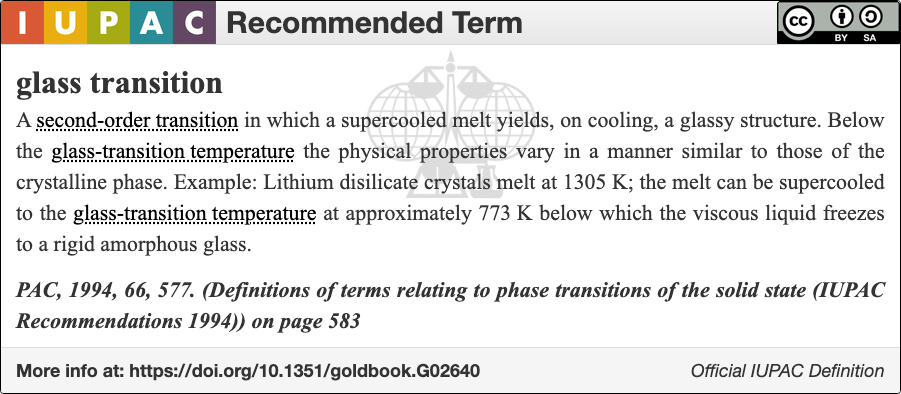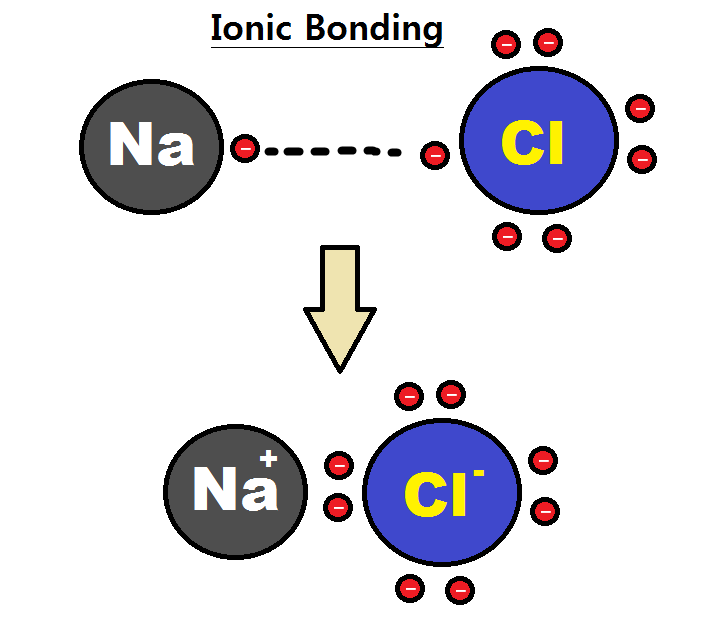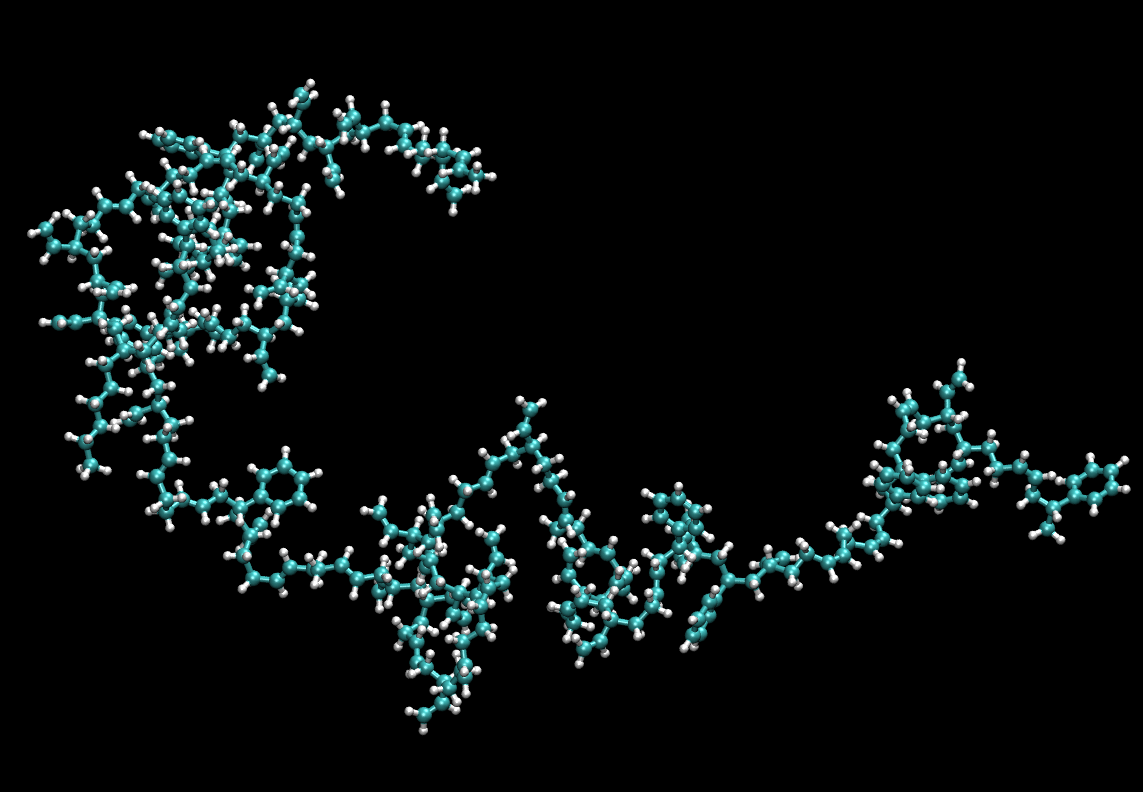|
Dynamic Mechanical Analysis
Dynamic mechanical analysis (abbreviated DMA) is a technique used to study and characterize materials. It is most useful for studying the viscoelastic behavior of polymers. A sinusoidal stress is applied and the strain in the material is measured, allowing one to determine the complex modulus. The temperature of the sample or the frequency of the stress are often varied, leading to variations in the complex modulus; this approach can be used to locate the glass transition temperature of the material, as well as to identify transitions corresponding to other molecular motions. Theory Viscoelastic properties of materials Polymers composed of long molecular chains have unique viscoelastic properties, which combine the characteristics of elastic solids and Newtonian fluids. The classical theory of elasticity describes the mechanical properties of elastic solids where stress is proportional to strain in small deformations. Such response to stress is independent of strain rate. The ... [...More Info...] [...Related Items...] OR: [Wikipedia] [Google] [Baidu] |
Thermal Analysis
Thermal analysis is a branch of materials science where the properties of materials are studied as they change with temperature. Several methods are commonly used – these are distinguished from one another by the property which is measured: * Dielectric thermal analysis: dielectric permittivity and loss factor * Differential thermal analysis: temperature difference versus temperature or time * Differential scanning calorimetry: heat flow changes versus temperature or time * Dilatometer, Dilatometry: volume changes with temperature change * Dynamic mechanical analysis: measures storage modulus (stiffness) and loss modulus (damping) versus temperature, time and frequency * Evolved gas analysis: analysis of gases evolved during heating of a material, usually decomposition products * Isothermal titration calorimetry * Isothermal microcalorimetry * Laser flash analysis: thermal diffusivity and thermal conductivity * Thermogravimetric analysis: mass change versus temperature or time ... [...More Info...] [...Related Items...] OR: [Wikipedia] [Google] [Baidu] |
Glass Transition
The glass–liquid transition, or glass transition, is the gradual and Reversible reaction, reversible transition in amorphous solid, amorphous materials (or in amorphous regions within Crystallinity, semicrystalline materials) from a hard and relatively brittle "glassy" state into a viscous or rubbery state as the temperature is increased. International Organization for Standardization, ISO 11357-2: Plastics – Differential scanning calorimetry – Part 2: Determination of glass transition temperature (1999). An amorphous solid that exhibits a glass transition is called a glass. The reverse transition, achieved by supercooling a viscous liquid into the glass state, is called vitrification. The glass-transition temperature ''T''g of a material characterizes the range of temperatures over which this glass transition occurs (as an experimental definition, typically marked as 100 s of relaxation time). It is always lower than the melting point, melting temperature, ''T''m, of the cr ... [...More Info...] [...Related Items...] OR: [Wikipedia] [Google] [Baidu] |
Thermomechanical Analysis
Thermomechanical analysis (TMA) is a technique used in thermal analysis, a branch of materials science which studies the properties of materials as they change with temperature. Thermomechanical analysis is a subdiscipline of the thermomechanometry (TM) technique. Related techniques and terminology Thermomechanometry is the measurement of a change of a dimension or a mechanical property of the sample while it is subjected to a temperature regime. An associated thermoanalytical method is thermomechanical analysis. A special related technique is thermodilatometry (TD), the measurement of a change of a dimension of the sample with a negligible force acting on the sample while it is subjected to a temperature regime. The associated thermoanalytical method is thermodilatometric analysis (TDA). TDA is often referred to as zero force TMA. The temperature regime may be heating, cooling at a rate of temperature change that can include stepwise temperature changes, linear rate of change, ... [...More Info...] [...Related Items...] OR: [Wikipedia] [Google] [Baidu] |
Inertia
Inertia is the natural tendency of objects in motion to stay in motion and objects at rest to stay at rest, unless a force causes the velocity to change. It is one of the fundamental principles in classical physics, and described by Isaac Newton in his Newton%27s_laws_of_motion#First, first law of motion (also known as The Principle of Inertia). It is one of the primary manifestations of mass, one of the core quantitative properties of physical systems. Newton writes: In his 1687 work ''Philosophiæ Naturalis Principia Mathematica'', Newton defined inertia as a property: History and development Early understanding of inertial motion Joseph NeedhamProfessor John H. Lienhard points out the Mozi (book), Mozi – based on a Chinese text from the Warring States period (475–221 BCE) – as having given the first description of inertia. Before the European Renaissance, the prevailing theory of motion in western philosophy was that of Aristotle (384–322 BCE). On the surface ... [...More Info...] [...Related Items...] OR: [Wikipedia] [Google] [Baidu] |
Two Types Of DMA Analyzers
2 (two) is a number, numeral and digit. It is the natural number following 1 and preceding 3. It is the smallest and the only even prime number. Because it forms the basis of a duality, it has religious and spiritual significance in many cultures. Mathematics The number 2 is the second natural number after 1. Each natural number, including 2, is constructed by succession, that is, by adding 1 to the previous natural number. 2 is the smallest and the only even prime number, and the first Ramanujan prime. It is also the first superior highly composite number, and the first colossally abundant number. An integer is determined to be even if it is divisible by two. When written in base 10, all multiples of 2 will end in 0, 2, 4, 6, or 8; more generally, in any even base, even numbers will end with an even digit. A digon is a polygon with two sides (or edges) and two vertices. Two distinct points in a plane are always sufficient to define a unique line in a nont ... [...More Info...] [...Related Items...] OR: [Wikipedia] [Google] [Baidu] |
Linear Variable Differential Transformer
The linear variable differential transformer (LVDT) – also called linear variable displacement transformer, linear variable displacement transducer, or simply differential transformer – is a type of electrical transformer used for measuring linear displacement (position along a given direction). It is the base of LVDT-type Displacement sensor, displacement sensors. A counterpart to this device that is used for measuring rotary displacement is called a ''rotary variable differential transformer'' (RVDT). Introduction LVDTs are robust, absolute linear position/displacement transducers; inherently frictionless, they have a virtually infinite cycle life when properly used. As AC operated LVDTs do not contain any electronics, they can be designed to operate at cryogenic temperatures or up to 1200 °F (650 °C), in harsh environments, and under high vibration and shock levels. LVDTs have been widely used in applications such as Turbine, power turbines, hydraulics, auto ... [...More Info...] [...Related Items...] OR: [Wikipedia] [Google] [Baidu] |
Displacement Sensor
Displacement measurement is the measurement of changes in directed distance (displacement). Devices measuring displacement are based on displacement sensors, which can be contacting or non-contacting. Some displacement sensors are based on displacement transducers, devices which convert displacement into another form of energy. Displacement sensors can be used to indirectly measure a number of other quantities, including deformation, distortion, thermal expansion, thickness (normally through the combination of two sensors), vibration, spindle motion, fluid level, strain and mechanical shock. Displacement sensors exist that can measure displacement on the order of nanometers or smaller. Application Displacement receivers can be used to study and observe the stress waves passing through a material after it is struck.Hsu, K., Cheng, C., Hsu, S., & Yu, P. (2022)Rapid assessment of fire damage to reinforced concrete structures using the surface wave method with contact and non-co ... [...More Info...] [...Related Items...] OR: [Wikipedia] [Google] [Baidu] |
Schematic Of DMA
A schematic, or schematic diagram, is a designed representation of the elements of a system using abstract, graphic symbols rather than realistic pictures. A schematic usually omits all details that are not relevant to the key information the schematic is intended to convey, and may include oversimplified elements in order to make this essential meaning easier to grasp, as well as additional organization of the information. For example, a subway map intended for passengers may represent a subway station with a dot. The dot is not intended to resemble the actual station at all but aims to give the viewer information without unnecessary visual clutter. A schematic diagram of a chemical process uses symbols in place of detailed representations of the vessels, piping, valves, pumps, and other equipment that compose the system, thus emphasizing the functions of the individual elements and the interconnections among them and suppresses their physical details. In an electronic circuit d ... [...More Info...] [...Related Items...] OR: [Wikipedia] [Google] [Baidu] |
Steric
Steric effects arise from the spatial arrangement of atoms. When atoms come close together there is generally a rise in the energy of the molecule. Steric effects are nonbonding interactions that influence the shape ( conformation) and reactivity of ions and molecules. Steric effects complement electronic effects, which dictate the shape and reactivity of molecules. Steric repulsive forces between overlapping electron clouds result in structured groupings of molecules stabilized by the way that opposites attract and like charges repel. Steric hindrance Steric hindrance is a consequence of steric effects. Steric hindrance is the slowing of chemical reactions due to steric bulk. It is usually manifested in ''intermolecular reactions'', whereas discussion of steric effects often focus on ''intramolecular interactions''. Steric hindrance is often exploited to control selectivity, such as slowing unwanted side-reactions. Steric hindrance between adjacent groups can also affect ... [...More Info...] [...Related Items...] OR: [Wikipedia] [Google] [Baidu] |
Intramolecular Force
An intramolecular force (from Latin ''intra-'' 'within') is any force that binds together the atoms making up a molecule. Intramolecular forces are stronger than the Intermolecular force, intermolecular forces that govern the interactions between molecules. Types The classical model identifies three main types of chemical bonds — ionic, covalent, and metallic — distinguished by the degree of charge separation between participating atoms. The characteristics of the bond formed can be predicted by the properties of constituent atoms, namely electronegativity. They differ in the magnitude of their Bond-dissociation energy, bond enthalpies, a measure of bond strength, and thus affect the physical and chemical properties of compounds in different ways. % of ionic character is directly proportional difference in electronegativity of bonded atom. Ionic bond An ionic bond can be approximated as complete transfer of one or more valence electrons of atoms participating in bond formati ... [...More Info...] [...Related Items...] OR: [Wikipedia] [Google] [Baidu] |
Intermolecular
An intermolecular force (IMF; also secondary force) is the force that mediates interaction between molecules, including the electromagnetic forces of attraction or repulsion which act between atoms and other types of neighbouring particles (e.g. atoms or ions). Intermolecular forces are weak relative to intramolecular forces – the forces which hold a molecule together. For example, the covalent bond, involving sharing electron pairs between atoms, is much stronger than the forces present between neighboring molecules. Both sets of forces are essential parts of force fields frequently used in molecular mechanics. The first reference to the nature of microscopic forces is found in Alexis Clairaut's work ''Théorie de la figure de la Terre,'' published in Paris in 1743. Other scientists who have contributed to the investigation of microscopic forces include: Laplace, Gauss, Maxwell, Boltzmann and Pauling. Attractive intermolecular forces are categorized into the following type ... [...More Info...] [...Related Items...] OR: [Wikipedia] [Google] [Baidu] |
Styrene-butadiene Rubber
Styrene-butadiene or styrene-butadiene rubber (SBR) describe families of synthetic rubbers derived from styrene and butadiene (the version developed by Goodyear is called Neolite). These materials have good abrasion resistance and good aging stability when protected by additives. In 2012, more than 5.4 million tonnes of SBR were processed worldwide. About 50% of car tires are made from various types of SBR. The styrene/butadiene ratio influences the properties of the polymer: with high styrene content, the rubbers are harder and less rubbery. SBR is not to be confused with the thermoplastic elastomer, styrene-butadiene block copolymer, although being derived from the same monomers. Types SBR is derived from two monomers, styrene and butadiene. The mixture of these two monomers is polymerized by two processes: from solution (S-SBR) or as an emulsion (E-SBR). E-SBR is more widely used. Emulsion polymerization E-SBR produced by emulsion polymerization is initiated by free r ... [...More Info...] [...Related Items...] OR: [Wikipedia] [Google] [Baidu] |



